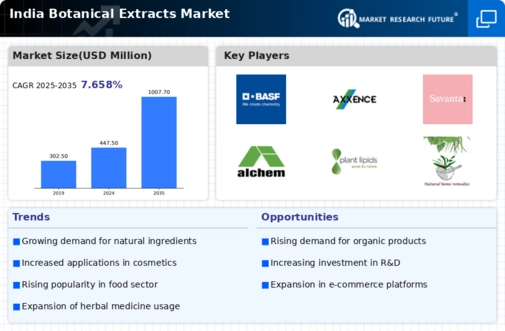Increasing Health Consciousness
The growing awareness of health and wellness among consumers in India appears to be a primary driver for the botanical extracts market. As individuals increasingly seek natural and organic products, the demand for botanical extracts, known for their therapeutic properties, is likely to rise. Reports indicate that the herbal supplement market in India is projected to reach approximately $5 billion by 2025, reflecting a compound annual growth rate (CAGR) of around 15%. This trend suggests that consumers are gravitating towards products that promote holistic health, thereby bolstering the botanical extracts market. Furthermore, the inclination towards preventive healthcare is likely to enhance the market's growth, as botanical extracts are often perceived as safer alternatives to synthetic ingredients.
Rising Popularity of Ayurvedic Products
Ayurveda, an ancient system of medicine in India, is experiencing a resurgence in popularity, which is likely to positively impact the botanical extracts market. The increasing acceptance of Ayurvedic products among consumers, driven by their perceived efficacy and natural origins, suggests a growing market potential. The Ayurvedic market in India is projected to reach $9 billion by 2022, with botanical extracts playing a crucial role in this growth. This trend indicates that consumers are increasingly turning to traditional remedies, which often utilize botanical extracts for their therapeutic benefits. As the demand for Ayurvedic products continues to rise, the botanical extracts market is expected to expand, catering to a diverse range of health and wellness needs.
Growing Interest in Sustainable Sourcing
Sustainability has emerged as a critical consideration for consumers and businesses alike, influencing the botanical extracts market. The increasing demand for ethically sourced and environmentally friendly products is prompting manufacturers to adopt sustainable practices in sourcing botanical ingredients. Reports suggest that the market for sustainably sourced botanical extracts is expected to grow at a CAGR of 14% in the coming years. This trend indicates a shift towards transparency and accountability in the supply chain, as consumers seek products that align with their values. As sustainability becomes a key driver in purchasing decisions, the botanical extracts market is likely to see a rise in demand for products that are not only effective but also responsibly sourced.
Expansion of the Food and Beverage Sector
The food and beverage industry in India is undergoing a transformation, with an increasing focus on incorporating natural ingredients. This shift is likely to drive the botanical extracts market, as manufacturers seek to enhance flavor, color, and nutritional value using plant-based extracts. The market for natural food colors, for instance, is expected to grow at a CAGR of 10% over the next few years, indicating a robust demand for botanical extracts. Additionally, the rise of health-oriented food products, such as functional beverages and organic snacks, is expected to further stimulate the market. As consumers become more discerning about their food choices, the botanical extracts market is poised to benefit from this trend, aligning with the broader movement towards clean label products.
Technological Advancements in Extraction Processes
Innovations in extraction technologies are likely to enhance the efficiency and quality of botanical extracts, thereby driving market growth. Techniques such as supercritical fluid extraction and ultrasonic extraction are becoming more prevalent, allowing for higher yields and better preservation of bioactive compounds. This advancement is particularly relevant in India, where the demand for high-quality botanical extracts is on the rise. The market for extraction technologies is expected to grow significantly, with a projected CAGR of 12% over the next five years. As manufacturers adopt these advanced methods, the botanical extracts market is likely to benefit from improved product offerings, meeting the evolving needs of consumers and industries alike.




















Leave a Comment